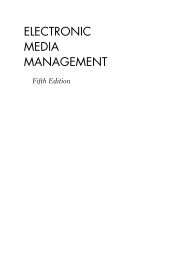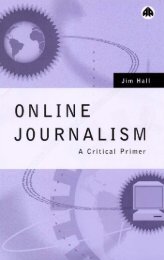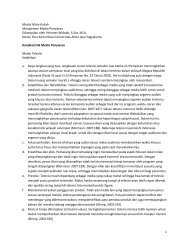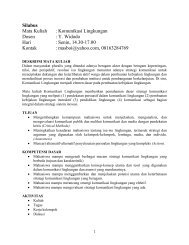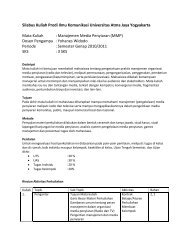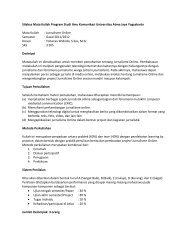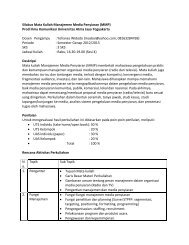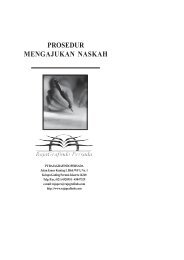Modul Mata Kuliah Journalisme Online - Ayo Menulis FISIP UAJY
Modul Mata Kuliah Journalisme Online - Ayo Menulis FISIP UAJY
Modul Mata Kuliah Journalisme Online - Ayo Menulis FISIP UAJY
Create successful ePaper yourself
Turn your PDF publications into a flip-book with our unique Google optimized e-Paper software.
However, an increase in competition also has led some news organizations to distinguish themselves<br />
from less responsible outlets by being more transparent about how they do their work. Journalists who<br />
want to set their articles apart as truthful and comprehensive have begun giving the public access to<br />
their sources. Studies are equipped with margins of error, assertions are backed by supporting web<br />
links, and anonymity granted to sources is thoroughly explained.<br />
While some journalists turn to transparency to justify the claims in their reports, others have resorted to<br />
a much more careless form of writing, dubbed “journalism of assertion.” Many blogs and independent<br />
e-zines, lacking an engrained sense of duty to the truth or to readers, have developed a journalistic style<br />
of unsubstantiated opinion. Ideas are accrued and then restated, without regard to their origin or<br />
factuality.<br />
The fact that information can be so easily accessed and then redistributed on the internet has lent itself<br />
to yet another trend: questioning the value of copyright. According to Piers Fawkes, co-creator of PSFK,<br />
a collaborative trend-reporting site, copyright has lost its value. “A blogger’s job is to spread ideas,”<br />
proclaims Fawkes. “They may be our ideas or the great ideas of others – but blogging gives an<br />
unparalleled way of passing those ideas on to others . . . the reason we write is not to control our ideas,<br />
not to look clever. We write to add our ideas to the global discussion.”<br />
Changes in news media audiences<br />
The proliferation of news outlets means that audiences can read and watch their news on various<br />
channels and web sites. In other words, media audiences have fragmented. No longer does an<br />
overwhelming majority of Canadians sit down in the evening to watch one or two major TV newscasts.<br />
People get their news updated throughout the day, when they want it. They surf the web to find the<br />
stories that interest them. Some describe these niche audiences as impatient, “remote control”<br />
audiences, who want the information they’re seeking without delay and without additional, unsought<br />
news.<br />
In response, more and more news outlets cater to smaller and smaller demographics or “niches.” The<br />
risk is that journalists will no longer seek to provide the public with comprehensive accounts of the day’s<br />
top stories from many areas of life, but will focus narrowly on “niche news” that is of interest to narrow<br />
sectors of the population. An additional danger is that the public will no longer come together, through<br />
the news media, to deliberate over common issues. Instead, the public will fragment into many specialinterest<br />
audiences.<br />
Convergence of media<br />
The fragmentation of the news audience has prompted some major news organizations to attempt to<br />
“re-assemble” a large news audience by providing news across many media platforms. Major<br />
organizations such as CNN in the United States and CanWest in Canada seek to own and provide news<br />
via a convergence of their newspapers, television stations and web sites. Meanwhile, journalists are<br />
urged to embrace multi-media reporting -- the ability to report for print, broadcast and the internet.<br />
Business Values<br />
As newsrooms become small parts of large corporations, there is a danger that profit-seeking and<br />
economic imperatives may cause newsrooms to compromise their ethical standards. Business values,<br />
such as the need to meet the demand of investors and advertisers, may trump journalistic integrity.<br />
Since many news companies are publicly financed corporations, newsroom owners or their senior staff<br />
may feel the pressure of investor-friendly quarterly reports. Inside the newsrooms, journalists may find



